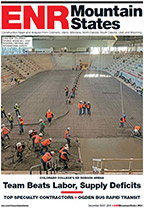It was 1964. The Beatles were taking America by storm. The Civil Rights Act became law. At the New York World's Fair, General Motors' Futurama ride touted continent-spanning highways. The National Aeronautics and Space Administration announced a $2-billion construction program to support the moon shot. The Chesapeake Bay Bridge Tunnel and New York City's Verazzano-Narrows Bridge opened.
Related Links: View the complete, first-ever ENR Top 400 list from 1964 ENR Top 400 Contractors 2014 Overview
And in its Aug. 6, 1964, issue, ENR magazine introduced its roundup of the 400 Largest Construction Contractors, the first time ENR published its Top 400 Contractors list. It was based on the volume of new construction contracts won in 1963 and was the result of a survey of U.S. construction contractors.
ENR had ranked contractors in the past; in fact, the first large list was published in 1958. In that list, ENR ranked 62 contractors based on new, domestic contract awards using 1956 data published in its "Construction Daily" publication, the forerunner to McGraw Hill Construction's Dodge reports.
"Over the years, ENR's business-news department had been reporting contract awards and bidding information," says Arthur Fox, ENR's editor at the time. "We could add up dollars' worth of contracts we had reported in the past year for each contractor, and we could rank the contractors. So we did."
The launch of the Top 400 was not without controversy. "There surely were criticisms and corrections called for in the early years," says Fox. But the ENR Top 400 quickly caught on, he notes. Rankings became "a matter of pride [and] a matter of competition" for contractors, Fox says.
Over the years, the Top 400 Contractors list has spun off other lists. The Top 400 subcontractor rankings became the ENR Top 600 Specialty Contractors list. The Top 400 rankings for international work became the ENR Top International Contractors and Top International Design Firms lists. And the Top 400 project-delivery lists spun off the stand-alone CM-at-Risk, Design-Build, CM-for-Fee and Program Management lists.
In 1994, ENR announced that future Top 400 Contractors lists would be based on contracting revenue, rather than new contracts, as massive, multi-year government contracts began to distort the previous ranking method. ENR also announced it would require either a financial statement verifying the accuracy of each firm's survey or a sign-off by the company's CEO or senior officer affirming the accuracy of the data submitted.
Whatever Happened To … ?
The firms on the list have changed over the years, of course. Many contracting giants from the first Top 400 list are long gone or have been acquired, merged or otherwise assimilated into other organizations.
The No. 1 firm on the 1964 list was Ebasco Services Inc., which was long associated with the design and construction of nuclear powerplants, including the Fukushima Daiichi plant in Japan, which melted down in 2011. Ebasco was acquired by Raytheon Engineers & Constructors, which was subsequently sold to Washington Group, later acquired by URS. Former employees still keep in touch. A Facebook page dedicated to Ebasco was created in 2008.
The No. 2-ranked firm was George A. Fuller Co., New York City, which built the original Pennsylvania Station in New York City, R.H. Macy's flagship store and the iconic Flatiron Building. Fuller was acquired by the Northrup (Aircraft) Corp. in 1971.
Third on the list was Morrison-Knudsen Co., the Boise, Idaho-based builder of the Hoover Dam. Washington Group acquired M-K in 1996.
Many other familiar names from the 1960s have disappeared. For example, S.J. Groves & Sons Co., Minneapolis, was ranked at No. 12 on the 1964 list but shut down in 1989 after the Groves family left the firm. And J.A. Jones Construction Co., Charlotte, N.C., was No. 17 in 1964 but closed in 2003, after its parent, Philipp Holzmann, Germany, collapsed.
Many contractors from the 1964 list continue to work under their own names as subsidiaries of other firms. For example, Stone & Webster—No. 24 in 1964—still does operations and maintenance on nuclear powerplants as a subsidiary of CB&I; Tishman Realty & Construction (No. 29) is a subsidiary of AECOM; The Austin Co. (No. 34) is owned by Kajima USA; T.L. James & Co. (No. 35) is now a unit of Primoris Services; and Guy F. Atkinson Co. (No. 69) is a subsidiary of Clark Group.
Some firms from the 1964 list continue in business but no longer do much construction. For example, No. 20 firm Koppers Co. Inc., Pittsburgh, reverted to its core business: chemicals and materials. No. 55, Starrett Bros. & Eken Inc., which built the Empire State Building, now is a developer and building manager. And Alhambra, Calif.-based Vinnell Corp.—No. 39 in 1964—now is owned by defense contractor Northrup Grumman and is a military training and support firm.
The industry has evolved over the past 50 years and will continue to do so. New firms continue to flourish and grow. For example, four contractors on the 2014 Top 400 were founded in 1964: Brasfield & Gorrie, The Yates Cos., Q&D Construction Inc. and MEDCO Construction. In a constantly changing industry, ENR's Top 400 will continue to track these changes, as it has for 50 years.












Post a comment to this article
Report Abusive Comment